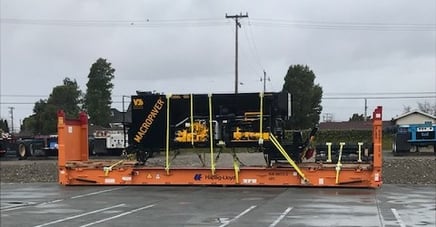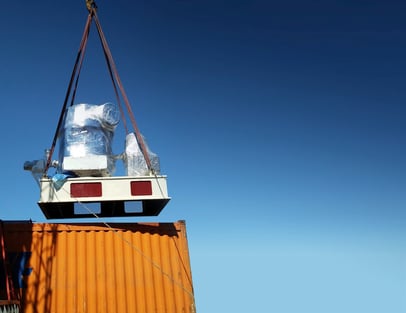You wouldn’t put on flip-flops to climb a mountain or go running with size-12 sneakers on your size-10 feet. Ocean containers are a bit like shoes: you need the right kind, and the right size, for your specific purpose.
Think “containers” and you might picture closed steel boxes rolling down the interstate on trucks, moving in long trains on the rails or stacked like Lego blocks on a container ship. These standard containers are the best choice for many kinds of cargo, including heavy freight shipping. But the market also offers other varieties for special requirements.
Here’s a quick guide to some of the most common cargo container types.
Standard container
This enclosed steel box is the most economical choice for any cargo that fits inside. Boxes, pallets, coils of steel wire, large machinery, household furniture, automobiles—as long as you can load it in and shut the doors, you’re good to go.
The standard container comes in 40-foot and 20 foot versions. If you need extra volume, you can choose a 40-foot high-cube container, one foot taller than a regular 40-footer but often no more expensive. Some carriers also offer 45-foot high-cubes, but these are harder to come by, so they cost more to use.
You’ll pay less to ship a 40-foot container than two 20-footers. So, if you’re transporting two smaller loads and your schedule allows, try to consolidate them into one shipment in a 40-foot box.
A standard container is water-tight, protecting cargo against rain, snow and salt water. But remember, even though it’s enclosed, the load can shift around in ways that might tip a truck or cause an avalanche when someone opens the doors at the destination. To avoid accidents, you need to secure the cargo correctly inside.
Flat rack
 Available in 40-foot and 20-foot versions, the flat rack container has walls at the front and back but is open on the sides and the top. Although it costs more than a standard container, it’s the right choice for an extra-wide load. It’s also one possible choice for a load that’s too tall for a standard container.
Available in 40-foot and 20-foot versions, the flat rack container has walls at the front and back but is open on the sides and the top. Although it costs more than a standard container, it’s the right choice for an extra-wide load. It’s also one possible choice for a load that’s too tall for a standard container.
Even if your cargo isn’t oversized, you might use the costlier flat rack if you need to load or unload from the top or side—for example, if there’s no loading dock available.
For cargo container types, if you choose a flat rack, keep in mind that its floor is a foot thicker than the floor of a standard container. A load that just hits the top of a standard container will extend one foot above the top of a flat rack. That overheight freight will be perfectly safe, but you’ll have to treat it as out-of-gauge cargo. You’ll do the same for a load that is more than 102 inches wide. Out-of-gauge cargo requires special permits when it travels on the road, making it more expensive to ship, and the railroads won’t take it at all.
Obviously, you have to secure the load properly on a flat rack. Since this container is open on top and at the sides, you’ll also need protection against the elements. Depending on what you’re shipping, you might, for example, use tarps or shrink wrap or place crates around the cargo.
Open top
 The open top container also comes in 40-foot and 20-foot versions. Like the flat rack, it’s good for overheight loads or for cargo that you load with an overhead crane. Because it comes with a standard floor, the open top gives you one more foot of height inside than you’ll get with a flat rack. But, of course, it won’t accommodate wide loads.
The open top container also comes in 40-foot and 20-foot versions. Like the flat rack, it’s good for overheight loads or for cargo that you load with an overhead crane. Because it comes with a standard floor, the open top gives you one more foot of height inside than you’ll get with a flat rack. But, of course, it won’t accommodate wide loads.
Some open top containers, called hard top containers, have removable steel roofs. They are a good choice for cargo of standard height. Once you load this kind of container type from overhead, you replace the roof, securing your cargo from the elements. But an overheight load requires a regular open top container. Its removable tarp cannot be used with overheight cargo; it must be stored inside the container together with the freight.
You’ll pay about the same for an open top container or for a flat rack. Both varieties cost more than standard containers.
Refrigerated container
A refrigerated container, or reefer, is an insulated steel box that includes equipment to maintain a specific temperature inside. Shippers use reefers, for example, to keep perishables cool, keep frozen foods from melting, or keep liquids from freezing.
All steamship lines provide 40-foot reefers, while only certain lines offer 20-footers.
The refrigeration equipment and insulating materials add weight to this kind of container. Unfortunately, that reduces how much you can load before you hit the maximum gross weight limit for highway transportation.
A refrigerated container costs more than a standard one, but if you’re shipping temperature-sensitive freight, you clearly need to use it. In some cases—say you’re shipping chocolate in winter—you might decide that the cargo is safe in a standard container. Or—again, in very specific situations—you might take advantage of the insulation in a reefer without powering up the refrigeration unit, thereby saving money. Or you might use an insulating liner (which you, not the carrier, will provide) to protect a load in a standard container.
If you use a refrigerated container, make sure to insure your load. Temperature control equipment usually works as expected, but not always. Imagine the pain of the company that avoids spending $150 on marine cargo insurance, only to lose $30,000 worth of ice cream to a power failure in August!
More to keep in mind about ocean cargo container types
- A load that appears to be oversized might actually fit in a standard container if you disassemble or rearrange it. The cost of dis-assembly and re-assembly can actually be less than the added cost of shipping in a non-standard container.
- Before you decide which kind of ocean cargo container to use, measure your load precisely, and make sure you understand the container dimensions. Don’t wait until the box arrives to find out your load won’t fit inside, or won’t fit through the doors or the open roof.
For help choosing the right container for every load, talk with the experts at I.C.E. Transport.





